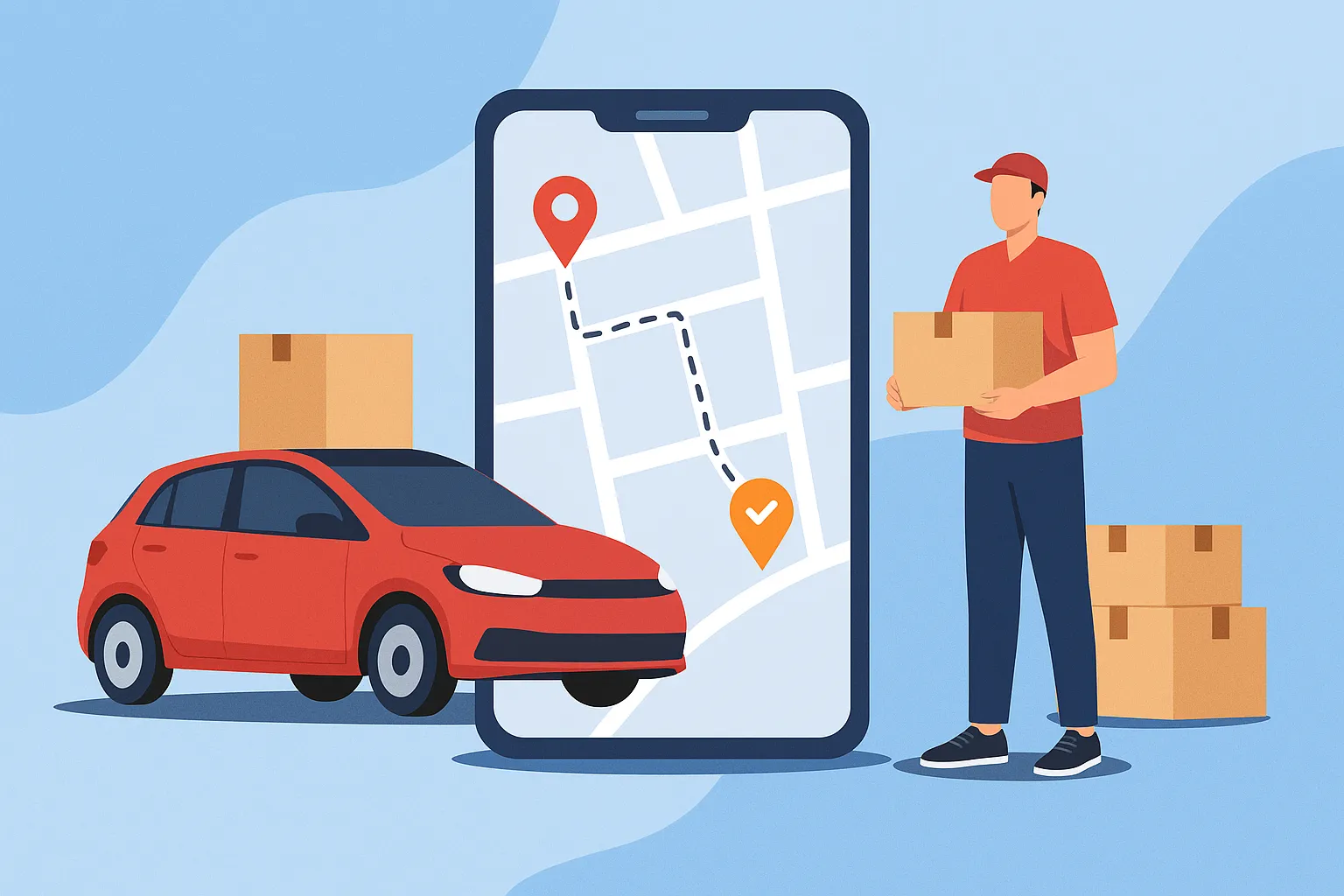The way we move packages today is completely different from just a few years ago. People don’t want to wait anymore—they expect instant updates, live tracking, and doorstep delivery within hours. Uber Delivery has led that shift, but it’s no longer the only player in town. In fact, more entrepreneurs are launching niche courier platforms powered by Uber Delivery Clone scripts.
These scripts are giving founders a head start—no need to build everything from zero. With a prebuilt foundation, they can launch faster, add custom logic, and adapt the app to local needs. If you’re thinking of building one, this guide will walk you through the best clone scripts in 2025, their features, pricing, and what to watch out for.
Why Entrepreneurs Choose Uber Delivery Clone Scripts
Speed to Market
Launching from scratch can take 6–12 months. A clone script can cut that down to 3–9 days with basic customization.
Customization Freedom
Clone apps aren’t just copies. You can rebrand them, modify user flows, and tailor them to specific business models—like express medicine delivery or cross-border logistics.
Proven Business Model
The Uber-style delivery structure has already been validated. That means less time experimenting and more time scaling.
Read More : How to Launch a Successful Logistics & Package Delivery App Business
Must-Have Features in a 2025 Uber Delivery Clone Scripts

In 2025, building a delivery app isn’t just about connecting senders and couriers—it’s about delivering a fast, seamless, and smart user experience that rivals industry giants. Today’s users demand real-time transparency, convenience, and reliability from every tap on their screen. To meet those expectations and compete effectively, your Uber Delivery Clone must go far beyond basic functionality. Here’s a breakdown of the essential features your platform absolutely must include:
Real-Time Package Tracking
Modern users expect full visibility into the delivery process. That means they should be able to open your app and instantly see where their courier is—live, on an interactive map—not just rely on vague “out for delivery” messages or static timestamps. Real-time GPS tracking gives users confidence, reduces missed deliveries, and improves overall satisfaction by keeping both senders and recipients in the loop throughout the delivery journey.
Route Optimization
Every extra minute spent in traffic or on the wrong route costs money and time. Your platform must integrate smart route optimization algorithms that automatically determine the most efficient delivery path based on real-time traffic, distance, package priority, and delivery windows. This not only increases the number of deliveries a driver can complete in a shift but also reduces fuel consumption, operational costs, and customer complaints about delays.
Contactless Delivery Options
Originally popularized for safety during the pandemic, contactless delivery has become a permanent user preference. It offers convenience for busy customers and peace of mind for health-conscious recipients. Your app should allow users to opt for contactless delivery at checkout, prompting drivers to drop off parcels at designated spots (like doorsteps or reception desks) and confirm delivery digitally—without any physical interaction.
In-App Communication
When something’s not clear—like where to park, how to access a gated building, or where to leave a fragile item—real-time communication becomes crucial. Your clone app must feature a secure in-app chat or call function that connects the courier and the sender or receiver instantly. Importantly, this communication should be privacy-protected, meaning no personal phone numbers are shared and all conversations are logged within the platform for security.
Proof of Delivery (POD)
Accountability is a big deal in delivery. To avoid disputes or fraud, your app needs to include multiple layers of delivery confirmation. This should include digital signatures from the recipient, auto-generated timestamps, and ideally, a geotagged photo of the delivered item at the drop location. A well-documented POD system helps prevent false complaints and ensures customer trust.
Admin Analytics Dashboard
Behind every smooth delivery experience is a powerful backend. Your admin dashboard should give you full operational visibility, including:
- Total and completed orders
- Revenue breakdown by day/week/month
- Fleet performance reports
- User growth and behavior metrics
- Peak hours and demand analysis
These analytics empower you to optimize operations, adjust pricing strategies, incentivize drivers, and identify problem areas before they escalate.
Heatmaps and Demand Zones
Every city has high-demand neighborhoods—business districts, campuses, apartment clusters. Your Uber Delivery Clone should feature heatmaps in the driver dashboard that highlight these zones in real time. This allows drivers to relocate proactively, reduce downtime, and increase completed deliveries per hour. As a business owner, this data also helps with marketing and resource allocation.
Multi-Language and Multi-Currency Support
If you’re aiming for scale—whether regional, national, or international—your app must accommodate linguistic and financial diversity. That means offering the app interface in multiple languages relevant to your target markets and allowing users to transact in local currencies. Currency auto-conversion, locale-specific formatting, and language preferences should be configurable at the user level to enhance accessibility and inclusivity.
Read More : Top 10 Ideas for Profitable Logistics and Courier Services Business Startups
Key Evaluation Metrics for Clone Scripts
When comparing Uber Delivery Clone scripts, consider these crucial performance areas:
- Scalability: Can it manage thousands of orders per day without server crashes or slowdowns?
- Customizability: Are colors, UI components, delivery logic, and payment gateways modifiable?
- Tech Stack: Is the app built on modern frameworks like Node.js, Flutter, or Laravel for future-proofing?
- Revenue Tools: Does it support tipping, surge pricing, referral bonuses, and commission models?
- Security Protocols: Ensure secure logins, OTPs, data encryption, and GDPR compliance are baked in.
- Deployment Readiness: Look for multi-platform support across Android, iOS, and web.
- Support Services: Does the vendor offer post-launch assistance, maintenance, and regular updates?
Pricing Breakdown: What to Expect in 2025
Pricing for Uber Delivery Clone scripts varies based on features, customization, and support. Here’s a general range:
- Basic License Script: $799 to $1,500
Includes core functionalities with minimal support or customization. - White-Label Solution: $2,000 to $3,500
Offers branding changes, minor design updates, and standard support. - Fully Customized Platform: $5,000 to $10,000
Tailored workflows, third-party integrations, custom UI, and extended tech support. - Add-ons: $300 to $1,000 each
Modules like advanced analytics, wallet systems, or loyalty programs are typically priced separately. - Recurring Costs:
Hosting, cloud servers, SMS services, and periodic maintenance may add $100–$500 monthly.
Cost Factors & Pricing Breakdown
Uber-Style On-Demand Delivery Platform — Market Price
| Development Level | Inclusions | Estimated Market Price (USD) |
|---|---|---|
| 1. Basic Delivery MVP Platform | User onboarding, delivery request creation, driver assignment, live tracking, order status, basic admin panel | $35,000 |
| 2. Full-Feature Delivery Marketplace Platform | Route optimization, multi-category delivery support, wallet & payouts, delivery scheduling, analytics dashboards, surge logic, driver earnings & reports | $70,000 |
| 3. Enterprise Logistics Delivery Ecosystem | Fleet & agent management, regional scaling, automated dispatch engine, subscription workflows, multi-hub delivery flows, finance automation, loyalty system | $150,000+ |
The above pricing reflects the typical global market cost of building an Uber-style delivery platform from scratch, where businesses spend months planning dispatch workflows, routing logic, driver management systems, and payment infrastructure before going live.
Miracuves Pricing for an Uber-Style Delivery Platform
Miracuves Price: Starts at $2,899
Miracuves provides a fully ready-to-launch Uber-style delivery system including order placement, driver assignment, trip tracking, wallet/payout automation, delivery workflows, and a powerful admin dashboard — all delivered at a fraction of the global development cost. The solution is engineered on a stable PHP tech stack and crafted for scalability, speed, and operational reliability.
Note
Your package includes full non-encrypted source code, complete deployment support, backend/API setup, admin panel configuration, and full publishing assistance for Android & iOS applications—ensuring your platform is 100% launch-ready and future-proof.
Launch your delivery platform in days while others spend $70,000+ and wait months — start with Miracuves and go live faster.
Delivery Timeline for an Uber-Like Platform with Miracuves
Estimated deployment timeline: 3–9 days, depending on:
- Delivery categories & multi-role workflows
- Payment gateway configuration & payout setup
- KYC & dispute logic depth
- Branding and UI customization
- Fleet, agent & subscription tiers
Tech Stack
This solution is developed using stable web frameworks — PHP, MySQL & Flutter, optimized for performance, scalability, and fast deployment.
Read More : FedEx vs Uber Delivery Business Model Comparison
Real-World Use Cases: Going Beyond General Courier Services
Several businesses have used Uber Delivery Clone scripts in unique ways:
- Eco-Friendly Local Delivery: One startup used electric bikes and green branding to deliver within a 10-km radius.
- University Logistics: A campus-only delivery app handled books, documents, and parcels between students and faculty.
- Reverse Logistics: Another platform specialized in e-commerce returns and pickups using flexible scheduling and proof of pickup.
These adaptations show the flexibility of the core Uber Delivery model.
Tips Before You Invest in a Script
Before purchasing any Uber Delivery Clone script, keep these best practices in mind:
- Request a Live Demo: Interact with both the customer app and admin panel to understand the UX flow and backend robustness.
- Check for Clean Code: Ask if the codebase is modular, readable, and scalable for future additions.
- Understand Ownership Terms: Will you receive full source code or just a limited license?
- Performance Testing: Simulate high order volumes to evaluate system response time and reliability.
- Integration Flexibility: Can the platform connect to APIs from mapping tools, payment gateways, and CRM systems?
Conclusion
In a market where customers demand instant, seamless delivery, the opportunity to build your own Uber-style app has never been greater. A strong clone script gives you the infrastructure to move fast, customize freely, and scale confidently. Just remember—what sets you apart won’t be the script alone, but how you shape it to serve your unique users and market. At Miracuves, we help innovators launch high-performance app clones that are fast, scalable, and monetization-ready. Ready to turn your idea into reality? Let’s build together.
Still have questions about Uber Delivery Clone scripts? Let’s clear them up.
What’s the difference between a clone script and a custom-built app?
Clone scripts offer a ready-made base you can modify, while custom apps are built from the ground up—costing more and taking longer.
Can I launch internationally with a clone script?
Yes, as long as the script supports regional languages, currencies, and logistics partners, you can scale it globally.
How fast can I launch my app using a clone?
With minor branding and basic features, many apps go live in 10–15 days.
Is there any legal risk in using a clone script?
No, as long as the script is original and doesn’t replicate copyrighted assets like logos or trademarks.
Can I add new features later after launch?
Absolutely. Choose a modular script that allows plug-and-play updates so you can evolve with market demands.
Will I need developers post-launch?
Yes, having access to a developer or technical partner helps you maintain, upgrade, and scale efficiently.
Related Articles








